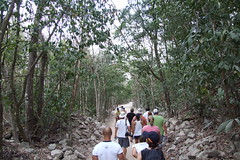
- some people sensibly decided they wouldn't be able to make the trek and hired a taxi bike (which cost 95 pesos for the round trip or about £4.60 - very reasonable) -
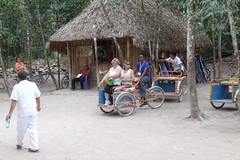
- as we staggered through the heat, so the guide would periodically pull the group together to show us interesting things -
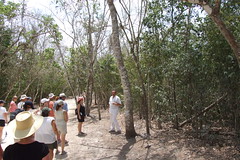
- this plant, for example, the Mayan people would pick off some of the peeling bark and chew to help with tooth ache and headaches -

- when scientists got hold of some and worked out what the active ingredient was, the world was given ibuprofen (Nurofen or Advil in the US)...I sneakily pulled some off and ate it, but spat it out - nasty bitter taste - we'll keep the pills I think...this next one -
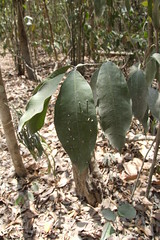
- he said a certain flying insect had laid eggs on the leaves, later the offspring would work their way to the interior of the tree and feed there - the tree is felled and the creamy matter left behind was used to treat diseases of the stomach - this was where the world outside found "Milk of Magnesia"...next up, something we had been waiting for, these two tiny patches of apparently white coloured mould -
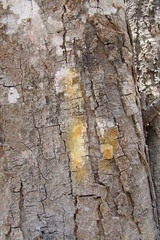

- burst into brilliant colour when the guide spat on his finger and rubbed them vigorously...this is the source of Mayan pigments (and these patches were few and far between, the amount of foraging required to colour even a tiny handkerchief would be considerable)...next he stopped us by a very sorry looking stick (with one tiny leaf just peeping out the top) -

- this, he explained, wasn't surprising...it was "Salvia divinorum", an extremely potent (in fact the most potent) naturally occurring psychoactive compound known to man...specimens further from the beaten path would likely have a few more leaves... ;)
This next plant, he said, was infected with something (and actually I'm not sure I needed him to tell me that), the wound that was still bleeding (two weeks later) on his hand occurred when he accidentally brushed against just such an infection during an earlier tour (suffice it to say we kept our distance) -
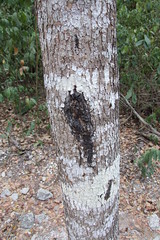
A short distance along the path, our attention was directed to a dark mass up in the trees, this is said was another signal used by the Mayan people to predict severe weather, the termites apparently have a sixth-sense for severe weather conditions and up-sticks (literally) the entire hive into the branches (quite why I'm not sure, maybe to be closer to their food supply), if people noticed new hives appearing up in the air, it was another clear signal bad times were neigh and to make sure everything was securely tied down...

Later we passed a funny looking tube, sticking out from a tree trunk, some people pointed at it and the guide ran in, looking very closely it was possible to see tiny (about a third of the size of UK bees) Mexican bees sitting inside (it was safe to go near, we were told, as Mexican bees have no sting) -

- so I took a macro shot while they patiently put up with my lens blocking the entrance (we hadn't noticed a single flower the whole time we had been walking, so they probably didn't have too much to do anyway)... ;)
The rest of the walk was conducted as quickly as we could, considering the conditions...we walked over one of the "sacbe" (the raised, white walkways that connected the various Mayan cities that we learned about when we visited Tulum), but it was now just a (many kilometre long) bump in the ground, completely overgrown...we passed the entrance to the other ball court (which was in a considerably worse state than the one we had seen already, so we skipped it)...Oh and noticed one thing the guide didn't point out -
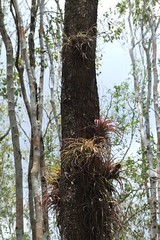
- some Epiphytic plants (called "air plants" in the UK) living comfortably without soil while hitching a ride on a rather taller cousin...funnily enough, extracts from these plants are used to make most common hay fever remedies (lots of medicine in the jungle)...
We pulled up into a huddle in an area of tiny trees just a little way further on and the guide settled everyone down, and then said "Nohoch Mul is just ahead, you have 30 minutes, the transport will leave without you if you do not get back in time. Please keep in mind it is 40 degrees centigrade, or about 104 Fahrenheit, you will have to climb almost vertically 140 feet on uneven, slippery polished stone, humidity is close to 98% and your insurance is unlikely to cover you, so please, think carefully before you walk through those trees"...
I took a peek through the trees to the base of the largest pyramid on the peninsula, greater even than El Castillo at Chichen Itza but in a state of terrible ruin...Flyingpops turned to me and said "Are you going to do it?"...I fixed my gaze, reeling slightly with anticipation of vertigo, gritted my teeth and then strode purposefully towards the bottom step...
No way was I coming all the way to Mexico and not climbing to the top...

3 comments:
Cor, can't wait for the next installment and thanks for the promotion of Senor Aardvark by the way
It was at this stage, I looked at Fink and said 'are you sure with your knee?'
All you can think is - This is probably the only time in my life this is going to be possible...and you reach out with both hands...Chichen Itza and Tulum are all roped off now...won't be long until Coba is the same...and there is a lot more world out there...will I really be going back to Mexico in a hurry (despite how amazing it was)...
Post a Comment